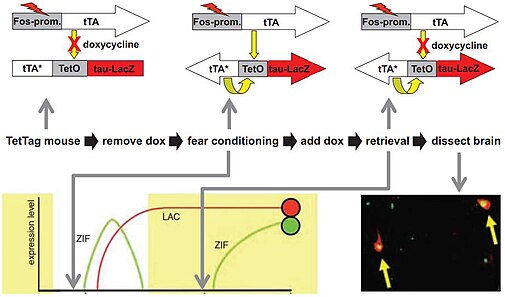TetTag

The TetTag mouse is a bi-transgenic mutant used in neuroscience research that expresses a persistent marker (e.g. beta-galactosidase) under control of the immediate early gene fos. This mouse strain allows the stable labeling of activated neurons in mice in a defined time window of several hours.
Description
Two independently generated transgenic strains were crossed to produce the TetTag strain. In the first transgenic construct, the tetracycline-controlled transactivator (tTA) protein and a two hour half-life Green Fluorescent Protein (shEGFP) are expressed under the direction of the fos minimal promoter. The second transgenic construct expresses a nuclear-localizing beta-galactosidase gene and the tetracycline regulated transactivator (tTA) under the control of the TetO tetracycline-responsive regulatory element.
Memory research
The TetTag mouse allows researchers to label activated neurons during a learning experiment (e.g. fear conditioning, water maze training). When the memory is retrieved days later, the acutely activated neurons can be labeled by immunohistochemistry against immediate early genes. These experiments test whether the same neurons are responsible for storing and retrieving a memory, a key question to understand the cellular mechanism of memory.
Limitations
The removal of doxycycline from the chow opens the window for activity-dependent labeling, but it takes several hours for the drug to be cleared from the brain. Thus, the labeling window is not very precise in time. Also, it is not entirely clear which activity patterns lead to Fos activation in neurons.